Our Lady of Aparecida
OUR LADY OF APARECIDA TIMELINE
c.1650: Frei Agnostino de Jesus, sculptor and carioca monk from Sao Paolo, made a small statue of the Virgin.
1717 (October 12): Joao Alves, a fisherman of Guarantinqueta, Brazil, cast his net in the Paraiba River near the Port of Itaguago and snared the body of a statue. He and his companions, Domingos Garcia and Felipe Pedroso, cast their net again, this time pulling up the statue’s head. They named the statue Our Lady Aparecida (Our Lady Who Appeared).
1732: The statue was taken to its first shrine.
1745: A larger church was built on a hilltop near Porto Itaguassu to house the statue.
1822: Pedro I declared Brazil’s independence from Portugal and elevated Our Lady Aparecida’s title to Patroness of Brazil.
1888: A larger basilica was built to replace smaller chapel that could accommodate 150,000 pilgrims a year.
1904 (September 8): St. Pius X declared Our Lady Aparecida to be Queen of Brazil. The Cardinal of Rio de Janeiro crowned her.
1930: Pope Pius XI proclaimed her as the principal patroness of Brazil.
1931 (May 31): Brazil was officially consecrated to Our Lady Aparecida.
1931: After a near-bloodless military coup d’etat, Getulio Vargas became dictator of Brazil. As a symbol of a united Brazil, he promoted a semi-official Catholic Church with Our Lady Aparecida as its symbol.
1945: Vargas’ ruled as dictator ended; plans already were underway for a new basilica.
1946-1955: Construction began on a large modern-style basilica.
1959: Masses, and the statue, were moved to the new basilica, still under construction.
1964: Another military takeover occurred in Brazil. Many socialists, including intellectuals and artists, were imprisoned or exiled. “President” Castello Branco named Our Lady Aparecida to be the highest general of the Brazilian Army in an attempt to restrict how public spaces could be used.
1978 (May 16): The statue was desecrated by a member of a Protestant sect.
1980: In anticipation of Pope John Paul II’s visit, the likely date of Our Lady’s discovery, October 12, was enacted into law as an official national Brazilian holiday.
1980 (October 12): Pope John Paul II blessed Our Lady’s shrine.
1995 (October 12): A televangelist pastor, Sergio Von Helder, publicly ridiculed an Aparecida icon during a televised religious service.
FOUNDER/GROUP HISTORY
Before Brazil fell under Spanish control in 1580, Joao III of Portugal controlled a vast territory but had few resources with which to settle and develop it. He therefore divided Brazil into fifteen captaincies and appointed a governor for each. The governors could levy taxes and rule as they saw fit but were required to populate the area, sustain the population, and defend their territories with their own resources. Gold was discovered in south-central Brazil in 1695 in what was to become the captaincies of Sao Paulo and Minas Gerais, and a mining boom ensued. A new governor for Sao Paulo and Minas Gerais, Pedro Miguel de Almeida Portugal e Vasconcellos, the Portuguese Count of Assumar, was due to arrive in his new captaincies, in a town later to be known as Aparaceda, in October, 1717 and was on his way to an important mining site (Johnson 1997).
The local residents wanted to provide a fitting reception for the new governor, and so three fishermen were sent out into the nearby Paraiba River to bring in food for a celebration. The discovery of the statue that came to be called Our Lady of Aparecida on that fishing expedition is “part history, part hagiography” (Johnson 1997:125). In the Roman Catholic Church, saints typically are consecrated after reportedly experiencing a vision or some other manifestation of God (hierophany). However, Our Lady of Aparecida’s path to becoming the Patroness of Brazil was quite distinctive.
Fish catches had not been plentiful immediately prior to the new governor’s visit, and the weather was especially bad when the men set out on their fishing trip. Despite their prayers to Our Lady of the Immaculate Conception (the Virgin Mary), for many hours Domingos Garcia, Joao Alves, and Felipe Pedroso caught nothing. Finally, casting his net once more, Alves hauled in not fish, but the body of a small statue. The statue had been in the river for a long time (and may have been a Spanish statue of the Virgin of Guadalupe from the period of Spanish control of Brazil between 1580 to 1640), and, as a result, the wood from which the statue was carved had been stained and discolored by the mud and water (Johnson 1997:126).
The men cast their net once more and brought in the statue’s head. They cleaned their catch and decided their statue was one of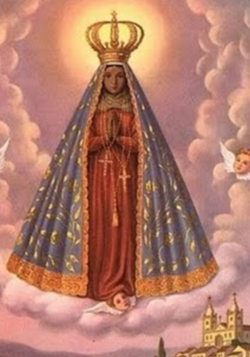 Our Lady of the Immaculate Conception, the Virgin Mary. They named her Our Lady of the Conception Who Appeared from the Waters, which was subsequently shortened to Our Lady Aparecida. The men wrapped her in cloth, continued fishing, and soon had enough fish to provide a sumptuous feast. The appearance of Our Lady of Aparecida came to be regarded as a double miracle. To the faithful, it was miraculous, first, that the fishermen found both the body and the head of the statue simultaneously and, second, that finding the statue was followed by a bountiful harvest of fish. This miracle resonates with a biblical narrative in which Jesus appears to unsuccessful fishermen, telling them to cast their nets again, which leads them to an abundant catch.
Our Lady of the Immaculate Conception, the Virgin Mary. They named her Our Lady of the Conception Who Appeared from the Waters, which was subsequently shortened to Our Lady Aparecida. The men wrapped her in cloth, continued fishing, and soon had enough fish to provide a sumptuous feast. The appearance of Our Lady of Aparecida came to be regarded as a double miracle. To the faithful, it was miraculous, first, that the fishermen found both the body and the head of the statue simultaneously and, second, that finding the statue was followed by a bountiful harvest of fish. This miracle resonates with a biblical narrative in which Jesus appears to unsuccessful fishermen, telling them to cast their nets again, which leads them to an abundant catch.
From the moment of its discovery, the statue was venerated by the fisherman and their families and neighbors. Felipe Pedroso took the statue to his house where others came to see her. When he moved to Porto Itaguassu, he took the statue with him. In 1732, his son Atanasio built its first shrine. Thirteen years after the first shrine was built, a larger church was erected on a hilltop near Porto Itaguassu for Our Lady of Aparecido. This remained her home for over a hundred years.
Pedro I declared Brazil’s independence from Portugal in 1822 and elevated Our Lady of Aparecida’s title to Patroness of Brazil, the constitutional separation of church and state notwithstanding. Our Lady of Aparecida became an increasingly more important destination for religious pilgrims in Brazil. By 1888, approximately 150,000 pilgrims were arriving every year. In response, a larger basilica was built to replace the smaller chapel. A succession of elevations of sacred status followed. On September 8, 1904, St. Pius X declared Our Lady of Aparecida to be the Queen of Brazil, and she was crowned by the Cardinal of Rio. Just twenty-six years later, in 1930, Pope Pius XI proclaimed her to be the principal patroness of Brazil, and Brazil was officially consecrated to Our Lady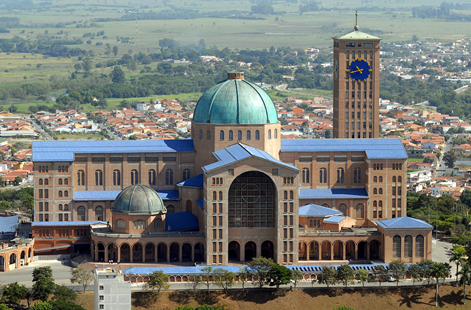 of Aparecida on May 31 of the next year. In 1931, Getulio Vargas seized power in Brazil after a military coup d’etat. While in power he sought to create a unified Brazil and so promoted a semi-official Catholic Church with Our Lady of Aparecida as its sign. Vargas’s reign as dictator ended in 1945, but by then the plans were already underway for a new basilica. In 1959, Our Lady of Aparecida was moved to the unfinished building. In the meantime, after a period of civilian government, military rule returned in 1964. Catello Branco, who was designated as president, symbolically named Our Lady of Aparecida to be the highest general of the Brazilian Army in an attempt to restrict how public spaces could be used. When the new basilica was finally completed in 1980, Pope John Paul II visited and blessed her shrine. His visit led to the creation of a law which named October 12, her likely date of discovery, an official national Brazilian holiday. The mixing of religious and political legitimation for Our Lady of Aparecida has been controversial but has also meant that Our Lady has been not only a symbol of the Catholic Church but also of Brazil as a nation (Johnson 1997:129).
of Aparecida on May 31 of the next year. In 1931, Getulio Vargas seized power in Brazil after a military coup d’etat. While in power he sought to create a unified Brazil and so promoted a semi-official Catholic Church with Our Lady of Aparecida as its sign. Vargas’s reign as dictator ended in 1945, but by then the plans were already underway for a new basilica. In 1959, Our Lady of Aparecida was moved to the unfinished building. In the meantime, after a period of civilian government, military rule returned in 1964. Catello Branco, who was designated as president, symbolically named Our Lady of Aparecida to be the highest general of the Brazilian Army in an attempt to restrict how public spaces could be used. When the new basilica was finally completed in 1980, Pope John Paul II visited and blessed her shrine. His visit led to the creation of a law which named October 12, her likely date of discovery, an official national Brazilian holiday. The mixing of religious and political legitimation for Our Lady of Aparecida has been controversial but has also meant that Our Lady has been not only a symbol of the Catholic Church but also of Brazil as a nation (Johnson 1997:129).
DOCTRINES/BELIEFS
Since her appearance in the river, Our Lady of Aparecida has always been associated with miracles. For example, after the statue 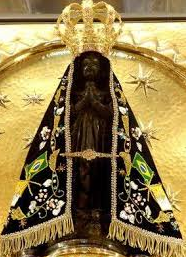 was first moved into its prayer chapel near the river, miraculous events were reported: candles that blew out in the chapel would relight, a slave running from a cruel master prayed to the idol for freedom and his chains were released, a blind girl received sight, and a man who wished to harm the statue found his horse’s feet “locked fast to the ground at the entrance of the building” when he tried to enter the chapel (“Our Lady Aparecida” n.d.). Further, while the new basilica was being constructed, it was reported that the every evening the statue was moved to reside in the in progressing Basilica, but every morning, she would appear back in the old Basilica. This went on for several years. Eventually, it is believed, the statue gave up and realized that no member of the clergy was going to heed her desire to remain at her old resting place.
was first moved into its prayer chapel near the river, miraculous events were reported: candles that blew out in the chapel would relight, a slave running from a cruel master prayed to the idol for freedom and his chains were released, a blind girl received sight, and a man who wished to harm the statue found his horse’s feet “locked fast to the ground at the entrance of the building” when he tried to enter the chapel (“Our Lady Aparecida” n.d.). Further, while the new basilica was being constructed, it was reported that the every evening the statue was moved to reside in the in progressing Basilica, but every morning, she would appear back in the old Basilica. This went on for several years. Eventually, it is believed, the statue gave up and realized that no member of the clergy was going to heed her desire to remain at her old resting place.
RITUALS/PRACTICES
The date dedicated to Our Lady of Aparecida has changed many times over the years. The original date in her honor was set as December 8 from as early as the eighteenth century. However, soon after the Vatican declared May to be the Month of Mary, the episcopate decided to make a special date devoted to Our Lady, the fifth Sunday after Easter, which would always fall in May. Just nine years later, in 1904, “the date was officially changed to the first Sunday of May” (Fernandes 1985:805). However, this date was not recognized by all of the churches, and some chose to use September 7, Independence Day, instead. Years later, in 1939, September 7 was officially established as the new day of Aparecida. Unfortunately, this led to a drastic drop in support from pilgrims at festivals in her honor, apparently as a result of both celebrations occurring on the same day. Thus, in 1955, the National Conference of Bishops moved the date for a final time to its current day, October 12. In 1980, this date became a national holiday.
There are several ritual themes that pilgrims to the Our Lady of Aparecida site express: dependence, territorial bond, and inclusion. The first is Dependence, in which pilgrims worship in order to get protection. This may also be accompanied by a vow, 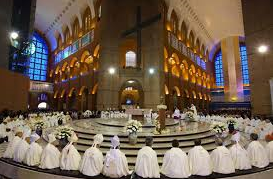 wherein the pilgrims may promise to accomplish something in the name of Our Lady of Aparecida if she will grant them something. The second is a Territorial Bond, wherein pilgrims bring items to be blessed by the statue to improve their relationship with Aparecida. Finally, there is Inclusion, which connotes that, while there are many rituals associated with Catholic Saints, all of them are related and equally important. This is directly contrasted, though, by the attitudes of pilgrims who come to see the idol. They generally arrive to visit the statue and nothing more. They do not confess their sins or hold much stock in the other aspects of Catholicism. In their minds, the statue of Our Lady of Aparecida is the only reality they need.
wherein the pilgrims may promise to accomplish something in the name of Our Lady of Aparecida if she will grant them something. The second is a Territorial Bond, wherein pilgrims bring items to be blessed by the statue to improve their relationship with Aparecida. Finally, there is Inclusion, which connotes that, while there are many rituals associated with Catholic Saints, all of them are related and equally important. This is directly contrasted, though, by the attitudes of pilgrims who come to see the idol. They generally arrive to visit the statue and nothing more. They do not confess their sins or hold much stock in the other aspects of Catholicism. In their minds, the statue of Our Lady of Aparecida is the only reality they need.
Pilgrims report extraordinary and miraculous experiences at the basilica. Dawsey (2006:7) writes that “They described the suffering of the pagadores de promessas (payers of promises) who carried crosses and climbed the stairways of the cathedral on their knees. They recalled the people stretched out on the floor of the basilica; they spoke of the people in rags, the sick and lame, and unemployed. At the end of the corridor, in the recesses of the church, they had seen the piles of crutches – allegories of the extraordinary healing powers of the saint. In the sala dos milagres (room of miracles), amid a stunning collection of enchanted objects, they saw up close the signs of the wonderful grace of the Mother of God.
ORGANIZATION/LEADERSHIP
While any organizational aspects of the lady, including where she resides, how she is dressed (a richly decorated robe is wrapped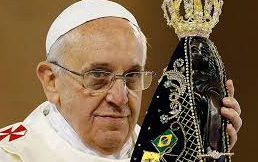 around her shoulders and a large crown adorns her head), what honors and special titles she has been given, and the official date for her celebration are controlled by various units of the Catholic church, one might say that actual leadership resides with the pilgrims. When Pope John Paul II visited Brazil in 1980 and great preparation was made to receive the expected increase in pilgrims to Aparecida to coincide with his visit, officials were surprised when no more than the normal 300,000 appeared, as opposed to the 2,000,000 who were expected. It seems that the pilgrims intended to follow their traditional schedules with regard to the Lady and to wait until the Pope visited their own locales to pay tribute to him.
around her shoulders and a large crown adorns her head), what honors and special titles she has been given, and the official date for her celebration are controlled by various units of the Catholic church, one might say that actual leadership resides with the pilgrims. When Pope John Paul II visited Brazil in 1980 and great preparation was made to receive the expected increase in pilgrims to Aparecida to coincide with his visit, officials were surprised when no more than the normal 300,000 appeared, as opposed to the 2,000,000 who were expected. It seems that the pilgrims intended to follow their traditional schedules with regard to the Lady and to wait until the Pope visited their own locales to pay tribute to him.
ISSUES/CHALLENGES
Our Lady of Aparecida has faced a series of challenges through her history. Despite her lofty status as Patroness of Brazil and the annual holiday in her honor, she has not been accepted by everyone in Brazil. Many Brazilians of different religions have expressed resentment toward her. Even some within the Catholic tradition believe that she is more of a hindrance than a help to believers.
In the earliest incident, Our Lady of Aparecida was also caught in the midst of a major power struggle. In 1889, the episcopate took over the sanctuaries and called in priests from Europe to assist in restructuring the belief system. This led to massive conflict, both “between the episcopate and local notables over administrative control” and also “between Tridentine-minded missionaries and the native pilgrims” over devotion (Fernandes 1985:804). The priests wanted to reconvert the pilgrims to Catholicism, yet they found that the pilgrims still practiced some Pagan rituals that had been part of their belief system for centuries and were resistant to change. As already noted, pilgrims regularly traveled to worship Our Lady of Aparecida, but one priest found that “90% of those 30,000 people [who visited the statue] had never confessed, or only once, in their entire lives” (Fernandes 1985:804). The Catholic Church has had a continuing struggle with the facts on the ground; while Our Lady of Aparecida is formally a Catholic icon, many of those who worship her do not closely follow Catholic doctrines.
As second incident occurred in 1978. A member of a Protestant sect took Our Lady of Aparecida from her pedestal and attempted to escape with the statue. He was chased and captured, but just before being apprehended, he smashed the statue to the ground. The statue was repaired, but it proved impossible to restore exactly the original features of the statue’s face.
Finally, on October 12, 1995 (which was a festival day), televangelist Segio Von Helder appeared on the 25 th Hour Program on the Record Television Network. In this segment, Helder criticized the prominence of the idol in Brazil’s culture, stating that “God is changed from principal actor to mere helper” (Johnson 1997:131). He then began to kick and beat the statue he had brought on the show with him. While this was a replica statue, his actions still caused an outrage among viewers. Both the network owner and the televangelist faced immediate and severe backlash from citizens. In the weeks that followed, there was an enormous spike in support for and devotion to the Lady, which coincided with extreme prejudice and anger toward the Igreja Universal, the parent network. Igreja Universal subsequently silenced him and sent him to the United States.
While Our Lady of Aparecida has been at the center of a number of conflicts through Brazil’s history, as the Patroness of Brazil she remains both a powerful symbol of the Roman Catholic tradition in the world’s most Catholic nation and of Brazilian national identity. Legions of pilgrims, both Catholic and non-Catholic, continue to trek to the basilica where the statue resides. Festivals honoring Our Lady of Aparecida are also held by diasporic populations in the United States (Arenson 1998).
REFERENCES
Arenson, Adam. 1998. “The Role of the Nossa Senhora Aparecida Festival in Creating Brazilian American Community.” New York Folklore 24:1-4.
Dawsey, John. 2006. “Joana Dark and the Werewolf Woman: The Rite of Passage of Our Lady.” Religião & Sociedade 2:1-13.
Fernandes, Rubem César. 1985. “Aparecida, Our Queen, Lady and Mother, Sarava!” Social Science Information. Accessed from http://ssi.sagepub.com/content/24/4/799 on 2 May 2014
Johnson, Paul C. 1997. “Kicking, Stripping, and Re-Dressing a Saint in Black: Visions of Public Space in Brazil’s Recent Holy War.” History of Religions 37:122-40.
Leon, Luis D. 2010. Teaching Language in Context.” Church History 79:504-06.
Oliveira, Plinio Correa de. “Our Lady of Aparecida – October 12.” n.d. Tradition In Action. Accessed from http://www.traditioninaction.org/SOD/j227sd_OLAparecida_10-12.html on 2 May 2014
“Our Lady of Aparecida” (Nossa Senhora Aparecida). n.d. Mary Pages. Accessed from http://www.marypages.com/LadyAparecida.htm on 2 May 2014.
Yeh, Allen and Gabriela Olaguibel. 2011. “The Virgin of Guadalupe: A Study of Socio-Religious Identity” International Journal of Frontier Missiology. 28:169-77.
Authors:
David G. Bromley
Caitlin St. Clair

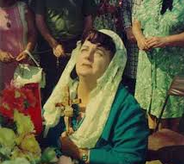 Marian seer. Lueken’s first mystical experiences followed the assassination of Senator Robert Kennedy on June 5, 1968. The next day, as Kennedy lay in the hospital, Lueken was praying for his recovery when she felt herself surrounded by an overwhelming fragrance of roses. Although the senator died late that night, the inexplicable smell of roses continued to haunt her. Soon she would wake up to find she had written poetry that she could not remember writing. She had prayed to St. Therese of Lisieux to save senator Kennedy and suspected that Therese was somehow the true author of these poems. She discussed these experiences with the priests at her parish church, St. Robert Bellarmine’s, but she felt they did not take her seriously. Her husband, Arthur, also discouraged any discussion of miracles.
Marian seer. Lueken’s first mystical experiences followed the assassination of Senator Robert Kennedy on June 5, 1968. The next day, as Kennedy lay in the hospital, Lueken was praying for his recovery when she felt herself surrounded by an overwhelming fragrance of roses. Although the senator died late that night, the inexplicable smell of roses continued to haunt her. Soon she would wake up to find she had written poetry that she could not remember writing. She had prayed to St. Therese of Lisieux to save senator Kennedy and suspected that Therese was somehow the true author of these poems. She discussed these experiences with the priests at her parish church, St. Robert Bellarmine’s, but she felt they did not take her seriously. Her husband, Arthur, also discouraged any discussion of miracles.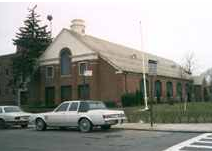 Bellarmine’s church in Bayside “when the roses are in bloom.” On the night of June 18, 1970, Lueken knelt alone in the rain praying the rosary before a statue of the Immaculate Conception outside her church. Here, Mary appeared to Lueken and instructed her that she was a bride of Christ, that she wept for the sins of the world, and that everyone must return to saying the rosary. Lueken announced that a national shrine should be built on the church grounds and that Mary would henceforth appear there on every Catholic feast day. Over the next two years, a small body of followers joined Lueken in her vigils in front of the statue. At each appearance, Lueken would deliver a “message from heaven,” spoken through her by Mary as well as a growing cast of saints and angels. These messages typically included jeremiads about the weight of America’s sins and warnings of a coming chastisement (Lueken 1998: vol. 1).
Bellarmine’s church in Bayside “when the roses are in bloom.” On the night of June 18, 1970, Lueken knelt alone in the rain praying the rosary before a statue of the Immaculate Conception outside her church. Here, Mary appeared to Lueken and instructed her that she was a bride of Christ, that she wept for the sins of the world, and that everyone must return to saying the rosary. Lueken announced that a national shrine should be built on the church grounds and that Mary would henceforth appear there on every Catholic feast day. Over the next two years, a small body of followers joined Lueken in her vigils in front of the statue. At each appearance, Lueken would deliver a “message from heaven,” spoken through her by Mary as well as a growing cast of saints and angels. These messages typically included jeremiads about the weight of America’s sins and warnings of a coming chastisement (Lueken 1998: vol. 1).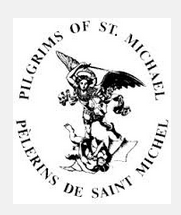 The Pilgrims were also known as “the White Berets” for the hats they wore. Like Lueken, they were disturbed by the reforms of Vatican II. The White Berets declared Lueken to be “the seer of the age” and printed her messages from heaven in their newsletter. They also began organizing buses that transported hundreds of pilgrims to attend vigils in front of Lueken’s parish church. Lueken’s messages began to hint at global conspiracies, a coming nuclear war, and a celestial body called “The Fiery Ball of Redemption” that would soon strike the Earth, causing planet-wide destruction.
The Pilgrims were also known as “the White Berets” for the hats they wore. Like Lueken, they were disturbed by the reforms of Vatican II. The White Berets declared Lueken to be “the seer of the age” and printed her messages from heaven in their newsletter. They also began organizing buses that transported hundreds of pilgrims to attend vigils in front of Lueken’s parish church. Lueken’s messages began to hint at global conspiracies, a coming nuclear war, and a celestial body called “The Fiery Ball of Redemption” that would soon strike the Earth, causing planet-wide destruction.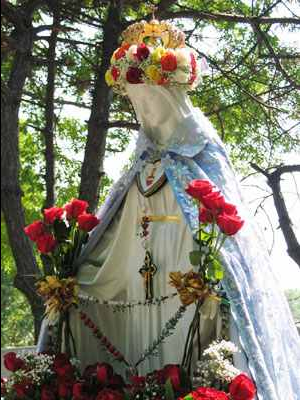
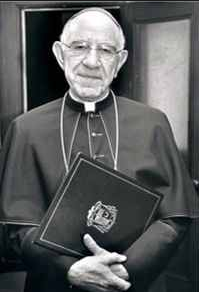 contradicted Catholic doctrine (Goldman 1987). Mugavero’s findings were sent to three hundred bishops throughout the United States and one hundred conferences of bishops around the world. Despite this censure from Church authorities, Lueken’s followers still identify as Catholics in good standing and they defend their views citing canon law. They contend that Lueken’s visions never received a proper investigation led by a bishop, and that the diocese’s dismissal of Lueken is therefore not legitimate. If anyone has violated Church law, they argue, it is the modernists whom Lueken condemned for receiving communion in the hand and other ritual transgressions that go against long-established Catholic tradition.
contradicted Catholic doctrine (Goldman 1987). Mugavero’s findings were sent to three hundred bishops throughout the United States and one hundred conferences of bishops around the world. Despite this censure from Church authorities, Lueken’s followers still identify as Catholics in good standing and they defend their views citing canon law. They contend that Lueken’s visions never received a proper investigation led by a bishop, and that the diocese’s dismissal of Lueken is therefore not legitimate. If anyone has violated Church law, they argue, it is the modernists whom Lueken condemned for receiving communion in the hand and other ritual transgressions that go against long-established Catholic tradition.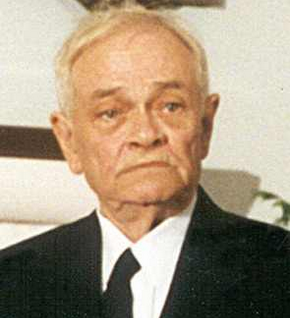 pilgrimages to Flushing Meadows with followers from around the world. But in 1997, a schism occurred between the shrine’s director, Michael Mangan, and Lueken’s widower, Arthur Lueken. A judge ruled in favor of Arthur Lueken, declaring him president of Our Lady of the Roses Shrine (OLR) and awarding him all of the organization’s assets and facilities. Undaunted, Mangan formed his own group, Saint Michael’s World Apostolate (SMWA). Both groups continued to arrive at the movement’s sacred site in Flushing Meadows where they held rival vigils. Once again, police were sent out to keep the peace (Kilgannon 2003). Today, this conflict has thawed into a detente. Their celebrations of Catholic feast days are sometimes timed such that only one group will be present in the park on a given day. For events where both groups must be present, such as Sunday morning holy hour, they alternate which group will have access to the monument. One group may set its statue of the Virgin Mary on the Vatican Monument, the other must use a nearby traffic island. The rival groups have decided it is in everyone’s interests to appear professional while in the park.
pilgrimages to Flushing Meadows with followers from around the world. But in 1997, a schism occurred between the shrine’s director, Michael Mangan, and Lueken’s widower, Arthur Lueken. A judge ruled in favor of Arthur Lueken, declaring him president of Our Lady of the Roses Shrine (OLR) and awarding him all of the organization’s assets and facilities. Undaunted, Mangan formed his own group, Saint Michael’s World Apostolate (SMWA). Both groups continued to arrive at the movement’s sacred site in Flushing Meadows where they held rival vigils. Once again, police were sent out to keep the peace (Kilgannon 2003). Today, this conflict has thawed into a detente. Their celebrations of Catholic feast days are sometimes timed such that only one group will be present in the park on a given day. For events where both groups must be present, such as Sunday morning holy hour, they alternate which group will have access to the monument. One group may set its statue of the Virgin Mary on the Vatican Monument, the other must use a nearby traffic island. The rival groups have decided it is in everyone’s interests to appear professional while in the park.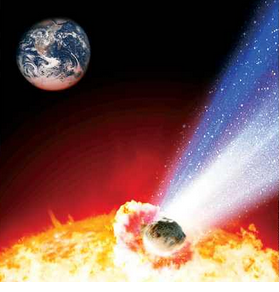 have been a trope in Marian apparitions since the nineteenth century. Lueken’s visions repeatedly described a fiery celestial object called “The Ball of Redemption” (possibly a comet, although this is not clear), that will collide with the Earth, killing much of the population. Her visions also describe World War III, which will include a full nuclear exchange. Horrifying descriptions of nuclear war have also been common in Marian Apparitions since the start of the Cold War. Unlike Protestant dispensationalism, Baysiders believe that the Chastisement can be postponed through prayer. When prophecies do not come to pass, Baysiders often take credit for earning the world a reprieve from judgment.
have been a trope in Marian apparitions since the nineteenth century. Lueken’s visions repeatedly described a fiery celestial object called “The Ball of Redemption” (possibly a comet, although this is not clear), that will collide with the Earth, killing much of the population. Her visions also describe World War III, which will include a full nuclear exchange. Horrifying descriptions of nuclear war have also been common in Marian Apparitions since the start of the Cold War. Unlike Protestant dispensationalism, Baysiders believe that the Chastisement can be postponed through prayer. When prophecies do not come to pass, Baysiders often take credit for earning the world a reprieve from judgment.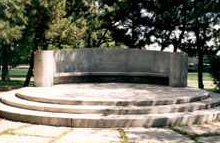 Hour” every Sunday that is dedicated to prayer for the priesthood. These events are held around a monument built in Flushing Meadows Park as part of the Vatican Pavilion during the 1964 World’s Fair. The monument, known as The Excedra, is a simple curved bench resembling an unrolling scroll. During vigils, the monument is transformed into a shrine. A fiberglass statue of Mary is ensconced on top of the bench and surrounded with by candles, flags representing the United States and the Vatican, and other ritual objects. The grounds are also consecrated with holy water.
Hour” every Sunday that is dedicated to prayer for the priesthood. These events are held around a monument built in Flushing Meadows Park as part of the Vatican Pavilion during the 1964 World’s Fair. The monument, known as The Excedra, is a simple curved bench resembling an unrolling scroll. During vigils, the monument is transformed into a shrine. A fiberglass statue of Mary is ensconced on top of the bench and surrounded with by candles, flags representing the United States and the Vatican, and other ritual objects. The grounds are also consecrated with holy water.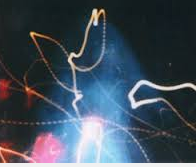 movement coincided with the development of Polaroid cameras. Many pilgrims took Polaroids during the vigils and found anomalies in the film. Most of these effects are easily attributable to user error or to ambient light sources like candles or car lights. Some, however, are more spectacular and difficult to explain. These anomalies were regarded as messages from heaven (Wojcik 1996, 2009). While Lueken was alive, people could bring her their “miraculous Polaroids” and she would interpret the streaks and blurs that appeared on the film, finding their symbolic significance (Chute and Simpson 1976). Today, ordinary Baysiders have developed codes to interpret the anomalies. During vigils, pilgrims take many photos and continue to find anomalies. While digital cameras are used, some Pilgrims prefer to use vintage Polaroid cameras like those used during the original vigils. Discovering a “message from heaven” in a photograph can be a source of great personal meaning for some Baysiders.
movement coincided with the development of Polaroid cameras. Many pilgrims took Polaroids during the vigils and found anomalies in the film. Most of these effects are easily attributable to user error or to ambient light sources like candles or car lights. Some, however, are more spectacular and difficult to explain. These anomalies were regarded as messages from heaven (Wojcik 1996, 2009). While Lueken was alive, people could bring her their “miraculous Polaroids” and she would interpret the streaks and blurs that appeared on the film, finding their symbolic significance (Chute and Simpson 1976). Today, ordinary Baysiders have developed codes to interpret the anomalies. During vigils, pilgrims take many photos and continue to find anomalies. While digital cameras are used, some Pilgrims prefer to use vintage Polaroid cameras like those used during the original vigils. Discovering a “message from heaven” in a photograph can be a source of great personal meaning for some Baysiders.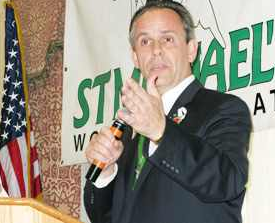 Park. Saint Michael’s World Apostolate is the larger group, which is led by Michael Mangan. Although a court awarded the name “Our Lady of the Roses Shrine” to Veronica Lueken’s widower, Mangan’s group had more support from pilgrims and acquired more infrastructure. When Our Lady of the Roses Shrine was unable to maintain their printing presses, Mangan’s group arranged to buy them. Saint Michael’s World Apostolate is headed by a group of men called the Lay Order of Saint Michael, who live together in a religious community. They are supported by numerous shrine workers who help to raise funds, disseminate the messages, and organize vigils.
Park. Saint Michael’s World Apostolate is the larger group, which is led by Michael Mangan. Although a court awarded the name “Our Lady of the Roses Shrine” to Veronica Lueken’s widower, Mangan’s group had more support from pilgrims and acquired more infrastructure. When Our Lady of the Roses Shrine was unable to maintain their printing presses, Mangan’s group arranged to buy them. Saint Michael’s World Apostolate is headed by a group of men called the Lay Order of Saint Michael, who live together in a religious community. They are supported by numerous shrine workers who help to raise funds, disseminate the messages, and organize vigils.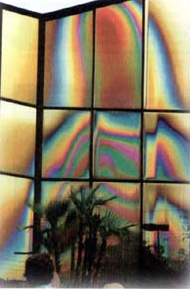
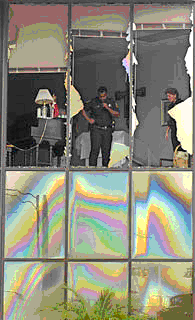
 reported Mary’s request for the distribution of not only “Mary’s Message,” but also several other books published by the Shepherds of Christ Ministries, including God’s Blue Book and Rosaries from the Hearts of Jesus and Mary. Further, many of the messages conveyed God’s wrath with human sinfulness and the failure to listen to previous messages, threatening humanity with fire, even citing religious negligence and divine wrath as the source of contemporary wildfires across Florida. There have also been prophecies of an imminent Endtime. All of Ring’s messages have been discerned by Father Carter.
reported Mary’s request for the distribution of not only “Mary’s Message,” but also several other books published by the Shepherds of Christ Ministries, including God’s Blue Book and Rosaries from the Hearts of Jesus and Mary. Further, many of the messages conveyed God’s wrath with human sinfulness and the failure to listen to previous messages, threatening humanity with fire, even citing religious negligence and divine wrath as the source of contemporary wildfires across Florida. There have also been prophecies of an imminent Endtime. All of Ring’s messages have been discerned by Father Carter.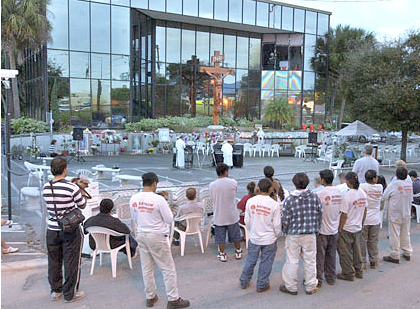 leave offerings to the Virgin, such as “candles, flowers, fruit, [and] beads, and participate in individual acts of piety (Posner 1997:2). Mary’s requests for pilgrims, as reported by Ring, include prayer, a daily recitation of the Ten Commandments at the site, recitation of the rosary, and an observance of the First Saturday devotion. In order to fulfill the Virgin’s requests to distribute her messages and lead others into prayer, audiotapes of “Mary’s Message” are played and rosaries, pamphlets, and brochures are provided by site staff (Swatos 2002:192). The focus on individual worship, rather than “the communal sense of the Mass,” is one of the primary factors setting the Clearwater group’s organization apart from traditional Catholic configuration (Swatos 2002).
leave offerings to the Virgin, such as “candles, flowers, fruit, [and] beads, and participate in individual acts of piety (Posner 1997:2). Mary’s requests for pilgrims, as reported by Ring, include prayer, a daily recitation of the Ten Commandments at the site, recitation of the rosary, and an observance of the First Saturday devotion. In order to fulfill the Virgin’s requests to distribute her messages and lead others into prayer, audiotapes of “Mary’s Message” are played and rosaries, pamphlets, and brochures are provided by site staff (Swatos 2002:192). The focus on individual worship, rather than “the communal sense of the Mass,” is one of the primary factors setting the Clearwater group’s organization apart from traditional Catholic configuration (Swatos 2002).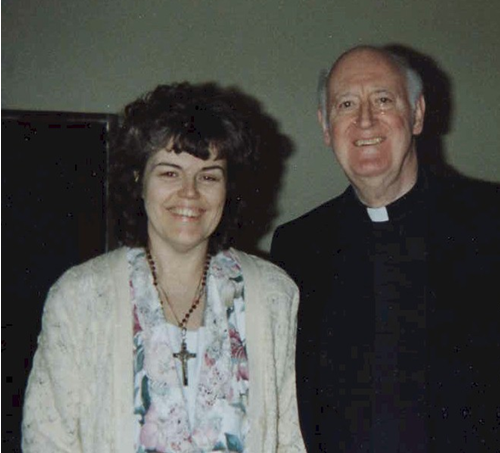 the Shepherds of Christ Ministry. She reportedly began receiving “private revelations” from Jesus and Mary in 1991, several years prior to reporting messages associated with the image at Our Lady of Clearwater. More is known about Father Edward Carter. He was brought up I Cincinnati, attended Xavier University, was ordained in the Jesuit Order when he was 33 years-old, and taught theology at Xavier University for nearly three decades. Carter reports having begun receiving messages from Jesus during the summer, 1993, and on the day before Easter in 1994 was told that he would now begin to receive messages for others (Carter 2010). He founded the Shepherds of Christ Ministry in 1994 after the Batavia Vissionary was instructed to include him with the other priests who were to receive messages through her and to carry out the special mission of establishing the Shepherds of Christ. Carter also received a message from Jesus in which he was told to undertake this mission and to include Rita Ring: ” I am requesting that a new prayer movement be started under the direction of Shepherds of Christ Ministries…. I will use this new prayer movement within My Shepherds of Christ Ministries in a powerful way to help in the renewal of My Church and the world. I will give great graces to those who join this movement…. I am inviting My beloved Rita Ring to be coordinator for this activity” (“About” 2006).
the Shepherds of Christ Ministry. She reportedly began receiving “private revelations” from Jesus and Mary in 1991, several years prior to reporting messages associated with the image at Our Lady of Clearwater. More is known about Father Edward Carter. He was brought up I Cincinnati, attended Xavier University, was ordained in the Jesuit Order when he was 33 years-old, and taught theology at Xavier University for nearly three decades. Carter reports having begun receiving messages from Jesus during the summer, 1993, and on the day before Easter in 1994 was told that he would now begin to receive messages for others (Carter 2010). He founded the Shepherds of Christ Ministry in 1994 after the Batavia Vissionary was instructed to include him with the other priests who were to receive messages through her and to carry out the special mission of establishing the Shepherds of Christ. Carter also received a message from Jesus in which he was told to undertake this mission and to include Rita Ring: ” I am requesting that a new prayer movement be started under the direction of Shepherds of Christ Ministries…. I will use this new prayer movement within My Shepherds of Christ Ministries in a powerful way to help in the renewal of My Church and the world. I will give great graces to those who join this movement…. I am inviting My beloved Rita Ring to be coordinator for this activity” (“About” 2006).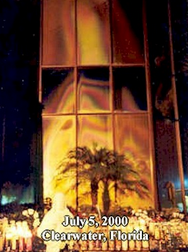 validated (“discerned) her messages. For a time she received messages daily that were made available in the Message Room along with video tapes. Ring visited what became the ” Mary Image Building” on the fifth of each month. Beginning in 2000, the year of Jubilee, the image has appeared to turn completely gold on that day.
validated (“discerned) her messages. For a time she received messages daily that were made available in the Message Room along with video tapes. Ring visited what became the ” Mary Image Building” on the fifth of each month. Beginning in 2000, the year of Jubilee, the image has appeared to turn completely gold on that day.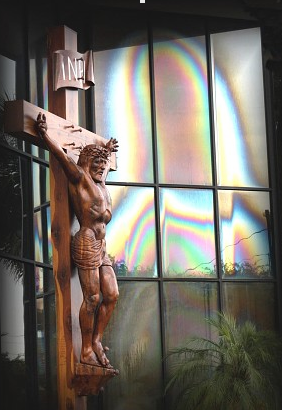
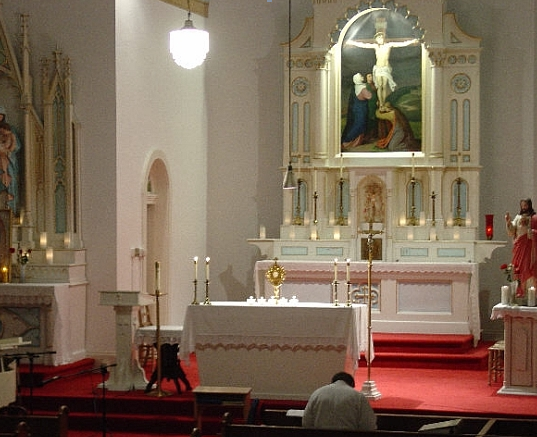 of Christ Ministries presents itself as a lay Catholic organization but has no formal relationship to the church. Site representatives have taken care not to challenge Roman Catholic Church authority. For example, the group indicated that it would seek permission from the local diocese before constructing a chapel at the site. Father Carter has repeatedly stated that “I recognize and accept that the final authority regarding private revelations rests with the Holy See of Rome, to whose judgment I willingly submit” (“News” n.d.). The Catholic diocese of St. Petersburg has disavowed any connection to Shepherds of Christ and has called the image a “naturally explained phenomenon.” However, the diocese has not launched an investigation of the site and has not condemned it (“Clearwater Madonna Changes Hands” 1998; Tisch 2004:4). There have other criticisms from within the Catholic community that conclude the apparitions are not authentic (Conte 2006).
of Christ Ministries presents itself as a lay Catholic organization but has no formal relationship to the church. Site representatives have taken care not to challenge Roman Catholic Church authority. For example, the group indicated that it would seek permission from the local diocese before constructing a chapel at the site. Father Carter has repeatedly stated that “I recognize and accept that the final authority regarding private revelations rests with the Holy See of Rome, to whose judgment I willingly submit” (“News” n.d.). The Catholic diocese of St. Petersburg has disavowed any connection to Shepherds of Christ and has called the image a “naturally explained phenomenon.” However, the diocese has not launched an investigation of the site and has not condemned it (“Clearwater Madonna Changes Hands” 1998; Tisch 2004:4). There have other criticisms from within the Catholic community that conclude the apparitions are not authentic (Conte 2006).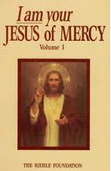 St. Maria Goretti Catholic Church. There, several young people as well as Father Jack Spaulding reported apparitions or locutions of Jesus and of Our Lady, appearing as Our Lady of Joy. These messages from Jesus have been published in six volumes of I Am Your Jesus of Mercy. In 1989, the diocese of Phoenix investigated the Scottsdale apparitions and took a neutral position on the matter.
St. Maria Goretti Catholic Church. There, several young people as well as Father Jack Spaulding reported apparitions or locutions of Jesus and of Our Lady, appearing as Our Lady of Joy. These messages from Jesus have been published in six volumes of I Am Your Jesus of Mercy. In 1989, the diocese of Phoenix investigated the Scottsdale apparitions and took a neutral position on the matter.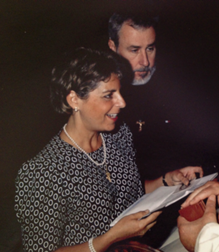 Grotto of Our Lady of Lourdes. Now run by Mt. St. Mary’s University, the site centers upon a replica of the 1858 apparition site in Lourdes, France, and also features a Glass Chapel and visitor’s center. A walkway winds through Stations of the Cross and a Rosary Walk, ending at the foot of a large metal Crucifix atop a wooded hill. This is where Gianna received her first apparition in Emmitsburg. Our Lady, clothed in a blue dress and white veil, invited Gianna and Michael to move to the small town, if they were willing. They were given three days to make the decision, and returned home to Arizona to consider the invitation.
Grotto of Our Lady of Lourdes. Now run by Mt. St. Mary’s University, the site centers upon a replica of the 1858 apparition site in Lourdes, France, and also features a Glass Chapel and visitor’s center. A walkway winds through Stations of the Cross and a Rosary Walk, ending at the foot of a large metal Crucifix atop a wooded hill. This is where Gianna received her first apparition in Emmitsburg. Our Lady, clothed in a blue dress and white veil, invited Gianna and Michael to move to the small town, if they were willing. They were given three days to make the decision, and returned home to Arizona to consider the invitation.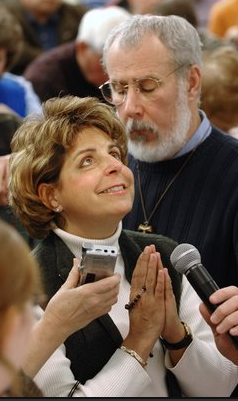 Group at St. Joseph Catholic Church in Emmitsburg. Gianna received a vision at her first prayer meeting, surprising fellow devotees when she fell to her knees and began conversing with Our Lady. Father Alfred Pehrsson, C.M., the parish pastor she had met during her January visit to Emmitsburg, explained to parishioners what had happened and implored them to keep quiet about what they had seen so as not to call undue attention to Gianna or the prayer group. Nevertheless, attendance at the Thursday Marian Prayer Group grew as news of the visionary spread. As many as 1,000 visitors attended weekly (Gaul 2002), including several priests, bishops from other countries, and even non-Catholic visitors. Close to 700,000 people attended between 1994 and 2008 (G. Sullivan 2008). Church groups throughout the region organized bus trips to Emmitsburg, and many families drove several hours to spend the day visiting the town. The numbers of conversions and confessions increased, and Fr. Pehrsson even heard confessions from Jewish and Protestant attendees (Pehrsson n.d.). Many attendees reported miracles during the service: a spinning sun or two suns, healings, and once, the lights of heaven visible in Gianna’s eyes during ecstasy. Every week, several rows of pews were reserved at the church for parishioners, but others had to arrive before noon (for the 7 PM service) in order to find a seat. Overflow crowds were directed to the church rectory across the street, where a television screen was set up so that all could see Gianna. Problematically, crowds set up blankets and chairs on the lawn and cemetery surrounding the church, and parked illegally throughout the small town. In response, some Protestant churches in the area opened their parking lots to pilgrims.
Group at St. Joseph Catholic Church in Emmitsburg. Gianna received a vision at her first prayer meeting, surprising fellow devotees when she fell to her knees and began conversing with Our Lady. Father Alfred Pehrsson, C.M., the parish pastor she had met during her January visit to Emmitsburg, explained to parishioners what had happened and implored them to keep quiet about what they had seen so as not to call undue attention to Gianna or the prayer group. Nevertheless, attendance at the Thursday Marian Prayer Group grew as news of the visionary spread. As many as 1,000 visitors attended weekly (Gaul 2002), including several priests, bishops from other countries, and even non-Catholic visitors. Close to 700,000 people attended between 1994 and 2008 (G. Sullivan 2008). Church groups throughout the region organized bus trips to Emmitsburg, and many families drove several hours to spend the day visiting the town. The numbers of conversions and confessions increased, and Fr. Pehrsson even heard confessions from Jewish and Protestant attendees (Pehrsson n.d.). Many attendees reported miracles during the service: a spinning sun or two suns, healings, and once, the lights of heaven visible in Gianna’s eyes during ecstasy. Every week, several rows of pews were reserved at the church for parishioners, but others had to arrive before noon (for the 7 PM service) in order to find a seat. Overflow crowds were directed to the church rectory across the street, where a television screen was set up so that all could see Gianna. Problematically, crowds set up blankets and chairs on the lawn and cemetery surrounding the church, and parked illegally throughout the small town. In response, some Protestant churches in the area opened their parking lots to pilgrims.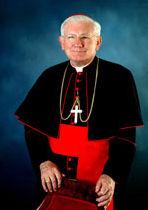 Commission was unfair to Gianna, spending very little time with her and prohibiting her supporters (including theologians) from speaking on her behalf. Gianna was permitted to answer only the questions posed to her by the Commission, rather than tell her whole story.
Commission was unfair to Gianna, spending very little time with her and prohibiting her supporters (including theologians) from speaking on her behalf. Gianna was permitted to answer only the questions posed to her by the Commission, rather than tell her whole story. Cult Watch , took a negative view of the apparitions, supporters, and visionary. Father Kieran Kavanaugh, O.C.D., Gianna’s spiritual advisor, was silenced when Cardinal Keeler ordered Fr. Kavanaugh’s superior to temporarily restrict the priest from attending the monthly prayer meetings. Father Alfred Pehrsson, the parish priest at St. Joseph who had since been relocated to another parish, was also asked by his superiors not to speak about the Emmitsburg apparitions. Both men have remained reticent to speak about the Emmitsburg events.
Cult Watch , took a negative view of the apparitions, supporters, and visionary. Father Kieran Kavanaugh, O.C.D., Gianna’s spiritual advisor, was silenced when Cardinal Keeler ordered Fr. Kavanaugh’s superior to temporarily restrict the priest from attending the monthly prayer meetings. Father Alfred Pehrsson, the parish priest at St. Joseph who had since been relocated to another parish, was also asked by his superiors not to speak about the Emmitsburg apparitions. Both men have remained reticent to speak about the Emmitsburg events.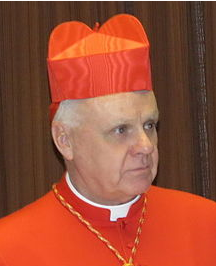 leadership, Gianna wrote a letter to Archbishop O’Brien informing him of the history of the apparitions in Emmitsburg and assuring him that she would comply with his wishes regarding the monthly prayer meetings held at Lynfield. Archbishop O’Brien did not respond to Gianna’s letter directly, but instead released a Pastoral Advisory in 2008 repeating the Church’s position that the messages were not supernatural. While he admitted in the Pastoral Advisory that there is nothing necessarily sacrilegious about the messages, he asserted his view that the “alleged apparitions are not supernatural in origin” (O’Brien 2008). He further “strongly” cautioned Mrs. Gianna Talone-Sullivan not to communicate in any manner whatsoever, written or spoken, electronic or printed, personally or through another in any church, public oratory, chapel or any other place or locale, public or private, within the jurisdiction of the Archdiocese of Baltimore any information of any type related to or containing messages or locutions allegedly received from the Virgin Mother of God.
leadership, Gianna wrote a letter to Archbishop O’Brien informing him of the history of the apparitions in Emmitsburg and assuring him that she would comply with his wishes regarding the monthly prayer meetings held at Lynfield. Archbishop O’Brien did not respond to Gianna’s letter directly, but instead released a Pastoral Advisory in 2008 repeating the Church’s position that the messages were not supernatural. While he admitted in the Pastoral Advisory that there is nothing necessarily sacrilegious about the messages, he asserted his view that the “alleged apparitions are not supernatural in origin” (O’Brien 2008). He further “strongly” cautioned Mrs. Gianna Talone-Sullivan not to communicate in any manner whatsoever, written or spoken, electronic or printed, personally or through another in any church, public oratory, chapel or any other place or locale, public or private, within the jurisdiction of the Archdiocese of Baltimore any information of any type related to or containing messages or locutions allegedly received from the Virgin Mother of God.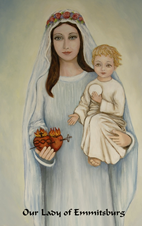 many messages assuring them that she is not leaving Emmitsburg. The February 5, 2006 message, for instance, assures listeners that Emmitsburg is the Center of Our Lady’s Immaculate Heart despite opposition from some Church leaders, then continues, “Know that I am not leaving and that I intercede for all good things for you before the Throne of God.” The October 5, 2008 message (just before the Pastoral Advisory was released) repeats this theme: “know that I am here with you. I am not leaving , even if you think I am far away.”
many messages assuring them that she is not leaving Emmitsburg. The February 5, 2006 message, for instance, assures listeners that Emmitsburg is the Center of Our Lady’s Immaculate Heart despite opposition from some Church leaders, then continues, “Know that I am not leaving and that I intercede for all good things for you before the Throne of God.” The October 5, 2008 message (just before the Pastoral Advisory was released) repeats this theme: “know that I am here with you. I am not leaving , even if you think I am far away.”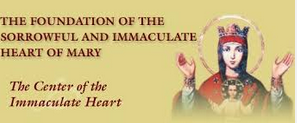 Revelations 12:1 is another helpful source of historical information. Both organizations maintain websites easily accessible by any internet search engine, the Foundation of the Sorrowful and Immaculate Heart of Mary and Private Revelations of Our Lady of Emmitsburg . Both organizations officially are located in Pennsylvania and are thus outside the jurisdiction of the Baltimore Archdiocese and its prohibitions. Notably, Gianna disavowed any involvement with The Foundation in her 2008 response to the Pastoral Advisory.
Revelations 12:1 is another helpful source of historical information. Both organizations maintain websites easily accessible by any internet search engine, the Foundation of the Sorrowful and Immaculate Heart of Mary and Private Revelations of Our Lady of Emmitsburg . Both organizations officially are located in Pennsylvania and are thus outside the jurisdiction of the Baltimore Archdiocese and its prohibitions. Notably, Gianna disavowed any involvement with The Foundation in her 2008 response to the Pastoral Advisory.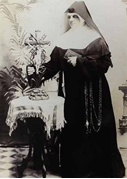 and several friends pledged to join a religious order. However, Brise continued to live with her parents in what was a relatively poor family until 1855 when the family emigrated to America. The family purchased a 240 acre tract of land to support itself. It was four years later, in October, 1859, just a short time after the Marian apparitions at Lourdes, that Brise had the first of three apparitional experiences. She was carrying grain to a mill in Champion, Wisconsin when the Virgin Mary appeared to her: “She saw a lady clothed in dazzling white, with a yellow sash around her waist and a crown of stars around her head standing between two trees, one a maple, the other a hemlock” (Shrine 2010). Brise found the experience frightening. On Sunday, October 9, the second apparitional event occurred when Brise was walking to Mass in Bay Settlement, a neighboring area, with two companions. Only Brise directly experienced the apparition. Finally, when walking home from church, Brise experienced an apparitional figure in the same place for a third and final time. Mary identified herself as the “Queen of Heaven” and told Brise that she must teach the children how to live their lives for God. From that day forward, Brise devoted her life to the teachings of the Catholic faith to young
and several friends pledged to join a religious order. However, Brise continued to live with her parents in what was a relatively poor family until 1855 when the family emigrated to America. The family purchased a 240 acre tract of land to support itself. It was four years later, in October, 1859, just a short time after the Marian apparitions at Lourdes, that Brise had the first of three apparitional experiences. She was carrying grain to a mill in Champion, Wisconsin when the Virgin Mary appeared to her: “She saw a lady clothed in dazzling white, with a yellow sash around her waist and a crown of stars around her head standing between two trees, one a maple, the other a hemlock” (Shrine 2010). Brise found the experience frightening. On Sunday, October 9, the second apparitional event occurred when Brise was walking to Mass in Bay Settlement, a neighboring area, with two companions. Only Brise directly experienced the apparition. Finally, when walking home from church, Brise experienced an apparitional figure in the same place for a third and final time. Mary identified herself as the “Queen of Heaven” and told Brise that she must teach the children how to live their lives for God. From that day forward, Brise devoted her life to the teachings of the Catholic faith to young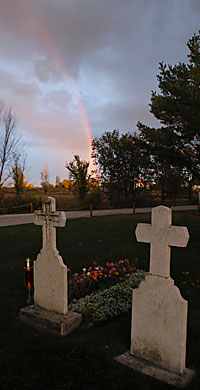 seemed uncertain. The school suffered without her presence and was passed into the hands of Sr. Pauline LaPlante, an original member of the Sisters of St. Francis of the Holy Cross of Bay Settlement (Kasten 2010). She worked to continue the school until her death in 1926 (Mann 2011). In the following years the school changed hands and faces several times. In 1933, it was remodeled as the Home for Crippled Children, and then in 1953, Bishop Paul Rhode discontinued the home and turned it into a pre-noviate high school for the Bay Settlement Sisters. In 1990, it became a House of Prayer for the Bay Settlement Sisters until 1990 when the diocese gained control of the grounds. The diocese converted the property into a shrine and welcomed in a group of Carmelite Sisters who founded the Carmel of the Holy Name of Jesus in 1992 (Kasten 2010). Ten years later the Carmel moved on to rural Denmark.
seemed uncertain. The school suffered without her presence and was passed into the hands of Sr. Pauline LaPlante, an original member of the Sisters of St. Francis of the Holy Cross of Bay Settlement (Kasten 2010). She worked to continue the school until her death in 1926 (Mann 2011). In the following years the school changed hands and faces several times. In 1933, it was remodeled as the Home for Crippled Children, and then in 1953, Bishop Paul Rhode discontinued the home and turned it into a pre-noviate high school for the Bay Settlement Sisters. In 1990, it became a House of Prayer for the Bay Settlement Sisters until 1990 when the diocese gained control of the grounds. The diocese converted the property into a shrine and welcomed in a group of Carmelite Sisters who founded the Carmel of the Holy Name of Jesus in 1992 (Kasten 2010). Ten years later the Carmel moved on to rural Denmark.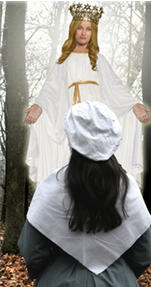 three at the site that would come to be known as Our Lady of Good Help. It was at the third apparitional event, which occurred while Brise was returning home from church that she received her spiritual mission (Shrine 2010; Kasten 2010). Brise reported that she asked the figure “In God’s name who are you and what do you want of me?” Mary reportedly then told Brise that she was the Queen of Heaven and assigned Brise a mission: “I am the Queen of Heaven who prays for the conversion of sinners, and I wish you to do the same. You received Holy Communion this morning and that is well. But you must do more. Make a general confession and offer Communion for the conversion of sinners. If they do not convert and do penance, my Son will be obliged to punish them.” Mary then offer more specific instructions: “Gather the children in this wild country and teach them what they should know for salvation.” When Brise inquired how she might accomplish this mission with little knowledge, Mary responded: “Teach them their catechism, how to sign themselves with the sign of the Cross, and how to approach the sacraments; that is what I wish you to do. Go and fear nothing. I will help you.”
three at the site that would come to be known as Our Lady of Good Help. It was at the third apparitional event, which occurred while Brise was returning home from church that she received her spiritual mission (Shrine 2010; Kasten 2010). Brise reported that she asked the figure “In God’s name who are you and what do you want of me?” Mary reportedly then told Brise that she was the Queen of Heaven and assigned Brise a mission: “I am the Queen of Heaven who prays for the conversion of sinners, and I wish you to do the same. You received Holy Communion this morning and that is well. But you must do more. Make a general confession and offer Communion for the conversion of sinners. If they do not convert and do penance, my Son will be obliged to punish them.” Mary then offer more specific instructions: “Gather the children in this wild country and teach them what they should know for salvation.” When Brise inquired how she might accomplish this mission with little knowledge, Mary responded: “Teach them their catechism, how to sign themselves with the sign of the Cross, and how to approach the sacraments; that is what I wish you to do. Go and fear nothing. I will help you.”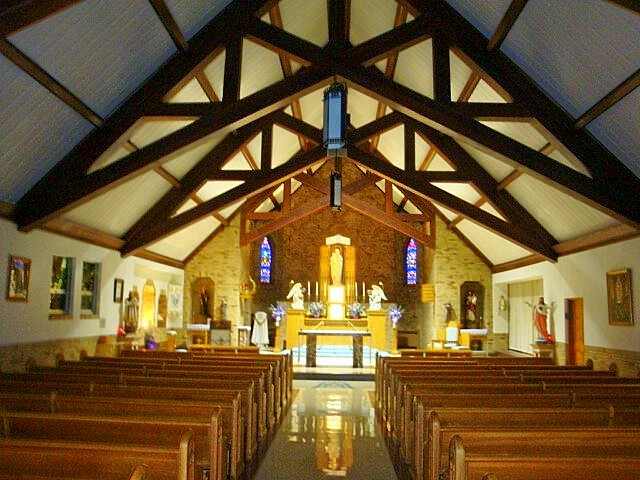 held four times a day in the chapel for those who wish for more than just individual reflection on site. Pilgrims testify to the extraordinary qualities of the site: “’It’s incredible — she’s here, you just feel it’, Ms. Banda said after praying in the crypt chapel, said to be on the spot of the apparitions. As they passed a statue of Mary in white, just as described by Ms. Brise, Ms. Banda was overcome with emotion, weeping and hugging her mother. The two of them went back to pray some more” (Eckholm 2010). Another pilgrim stated that “There’s a lot of power here….You can feel the presence of Mary, and it feels like she’s listening to you” (Eckholm 2010). Many crutches and canes are left behind at the shrine’s crypt. The owners of these items leave them saying that they no longer need their assistance.
held four times a day in the chapel for those who wish for more than just individual reflection on site. Pilgrims testify to the extraordinary qualities of the site: “’It’s incredible — she’s here, you just feel it’, Ms. Banda said after praying in the crypt chapel, said to be on the spot of the apparitions. As they passed a statue of Mary in white, just as described by Ms. Brise, Ms. Banda was overcome with emotion, weeping and hugging her mother. The two of them went back to pray some more” (Eckholm 2010). Another pilgrim stated that “There’s a lot of power here….You can feel the presence of Mary, and it feels like she’s listening to you” (Eckholm 2010). Many crutches and canes are left behind at the shrine’s crypt. The owners of these items leave them saying that they no longer need their assistance.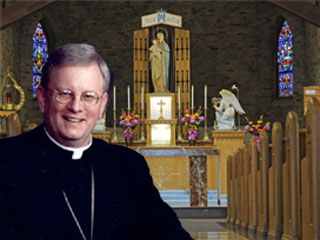 (“Wisconsin Site” 2011). He stated that “I declare with moral certainty and in accord with the norms of the Church that the events, apparitions and locutions given to Adele Brise in October of 1859 do exhibit the substance of supernatural character, and I do hereby approve these apparitions as worthy of belief (although not obligatory) by the Christian faithful” (“Marian Apparitions” 2010).
(“Wisconsin Site” 2011). He stated that “I declare with moral certainty and in accord with the norms of the Church that the events, apparitions and locutions given to Adele Brise in October of 1859 do exhibit the substance of supernatural character, and I do hereby approve these apparitions as worthy of belief (although not obligatory) by the Christian faithful” (“Marian Apparitions” 2010).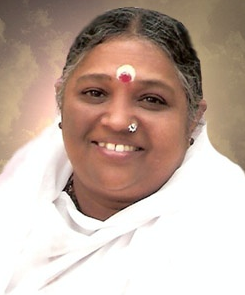 possessing extraordinary powers. According to these accounts, the signs of Sudhamani’s future spirituality began prior to her birth. During pregnancy her mother “began having strange visions. Sometimes she had wonderful dreams of Lord Krishna. At others she beheld the divine play of Lord Shiva and Devi, the Divine Mother” (Amritaswarupanada 1994:13). When Sudhamani was born she had a dark blue complexion and would lay in the lotus position of hatha yoga (chinmudra). By the time that she was six months old “she began speaking in her native tongue, and at the age of two began singing devotional songs to Sri Krishna…[E]even at an early age Sudhamani exhibited certain mystical and suprahuman traits, including compassion for the destitute. In her late teens, she developed an intense devotion to and longing for Krishna…sometimes she danced in spiritual ecstasy, and at other times she wept bitterly at the separation from her beloved Krishna” (Raj 2004:206). Sudhanami reportedly was so absorbed with Lord Krishna that “If she suddenly realized she had taken several steps without remembering Krishna, she would run back and walk those steps again, repeating the Lord’s name” (Johnsen 1994:95).
possessing extraordinary powers. According to these accounts, the signs of Sudhamani’s future spirituality began prior to her birth. During pregnancy her mother “began having strange visions. Sometimes she had wonderful dreams of Lord Krishna. At others she beheld the divine play of Lord Shiva and Devi, the Divine Mother” (Amritaswarupanada 1994:13). When Sudhamani was born she had a dark blue complexion and would lay in the lotus position of hatha yoga (chinmudra). By the time that she was six months old “she began speaking in her native tongue, and at the age of two began singing devotional songs to Sri Krishna…[E]even at an early age Sudhamani exhibited certain mystical and suprahuman traits, including compassion for the destitute. In her late teens, she developed an intense devotion to and longing for Krishna…sometimes she danced in spiritual ecstasy, and at other times she wept bitterly at the separation from her beloved Krishna” (Raj 2004:206). Sudhanami reportedly was so absorbed with Lord Krishna that “If she suddenly realized she had taken several steps without remembering Krishna, she would run back and walk those steps again, repeating the Lord’s name” (Johnsen 1994:95).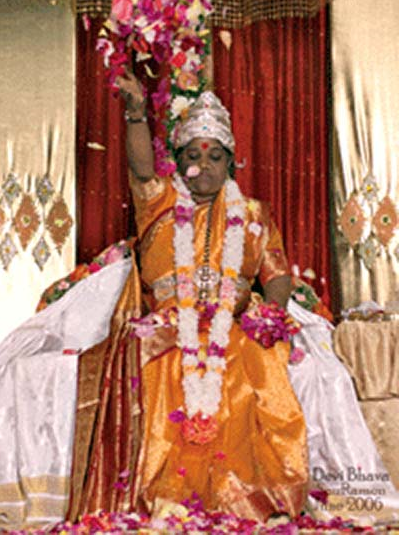 by a female disciple who performs the ritual foot worship (pada puja) by sprinkling water on Ammachi’s feet, then placing sandal paste and flowers on them. Two monks recite from the Sanskritic slokas, followed by the ceremonial waving of a lamp. Another devotee decorates Ammachi with a garland. There is a lecture on Ammachi’s message and spirituality. Finally, Ammachi and an Indian band lead the devotional singing (bhajan). After a period of meditation, Ammachi’s devotees are invited to approach her individually for her trademark embrace.
by a female disciple who performs the ritual foot worship (pada puja) by sprinkling water on Ammachi’s feet, then placing sandal paste and flowers on them. Two monks recite from the Sanskritic slokas, followed by the ceremonial waving of a lamp. Another devotee decorates Ammachi with a garland. There is a lecture on Ammachi’s message and spirituality. Finally, Ammachi and an Indian band lead the devotional singing (bhajan). After a period of meditation, Ammachi’s devotees are invited to approach her individually for her trademark embrace.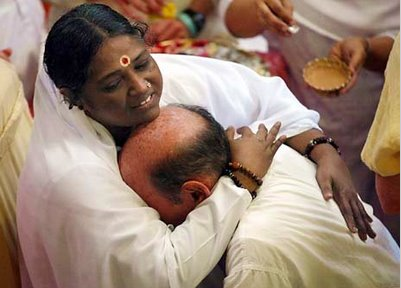 Amma embraces or kisses someone, it is a process of purification and inner healing. Amma is transmitting a part of Her pure vital energy into Her children. It also allows them to experience unconditional love. When Amma holds someone it can help to awaken the dormant spiritual energy within them, which will eventually take them to the ultimate goal of Self-realization” (Raj 2005:136-7). One of Ammachi’s devotees communicates the power of this encounter as follows: “Ammachi gives all the time, twenty four hours a day…She lavishes her love freely on everyone who comes to her. She may be firm with them, but she always radiates unconditional love. That’s why people are so shaken after they meet her. She’s a living example of what she teaches, of what all the scriptures teach” (Johnsen 1994:100).
Amma embraces or kisses someone, it is a process of purification and inner healing. Amma is transmitting a part of Her pure vital energy into Her children. It also allows them to experience unconditional love. When Amma holds someone it can help to awaken the dormant spiritual energy within them, which will eventually take them to the ultimate goal of Self-realization” (Raj 2005:136-7). One of Ammachi’s devotees communicates the power of this encounter as follows: “Ammachi gives all the time, twenty four hours a day…She lavishes her love freely on everyone who comes to her. She may be firm with them, but she always radiates unconditional love. That’s why people are so shaken after they meet her. She’s a living example of what she teaches, of what all the scriptures teach” (Johnsen 1994:100).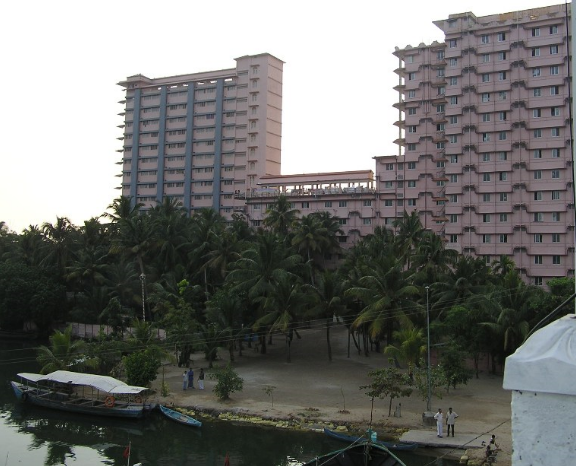 Two years later Amritapuri, her first formal ashram, was constructed. The ashram has continued to grow and now includes a temple a large dormitory. There are several hundred permanent residents and several hundred more visitors along with a small coterie of initiated, renunciate sannyasis and sannyasinis. The permanent residents at Ammachi’s ashrams, brahmacharins, follow a strict program of discipline (tapas), which “stipulates eight hours of meditation daily in addition to constant social service activities.
Two years later Amritapuri, her first formal ashram, was constructed. The ashram has continued to grow and now includes a temple a large dormitory. There are several hundred permanent residents and several hundred more visitors along with a small coterie of initiated, renunciate sannyasis and sannyasinis. The permanent residents at Ammachi’s ashrams, brahmacharins, follow a strict program of discipline (tapas), which “stipulates eight hours of meditation daily in addition to constant social service activities.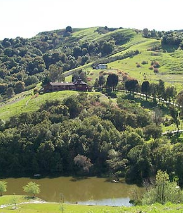 positions. According to Raj (2005:130), “Western disciples seem more attracted to the asceticism of Ammachi’s spirituality….Indians seem more drawn to the devotional tradition Ammachi embodies.” The highest levels of movement leadership continue to be held by male renunciant devotees. Converts from Siddha Yoga and Transcendental Meditation are commonplace (Raj 2004:210).
positions. According to Raj (2005:130), “Western disciples seem more attracted to the asceticism of Ammachi’s spirituality….Indians seem more drawn to the devotional tradition Ammachi embodies.” The highest levels of movement leadership continue to be held by male renunciant devotees. Converts from Siddha Yoga and Transcendental Meditation are commonplace (Raj 2004:210).